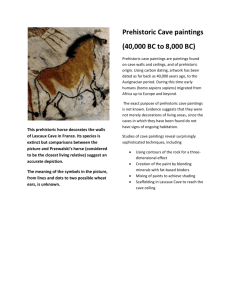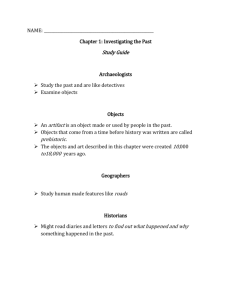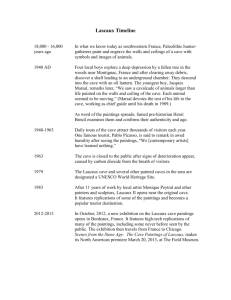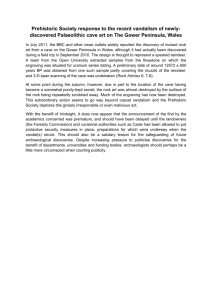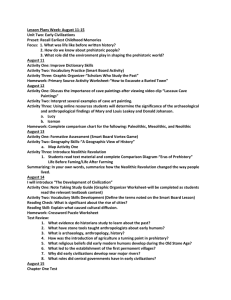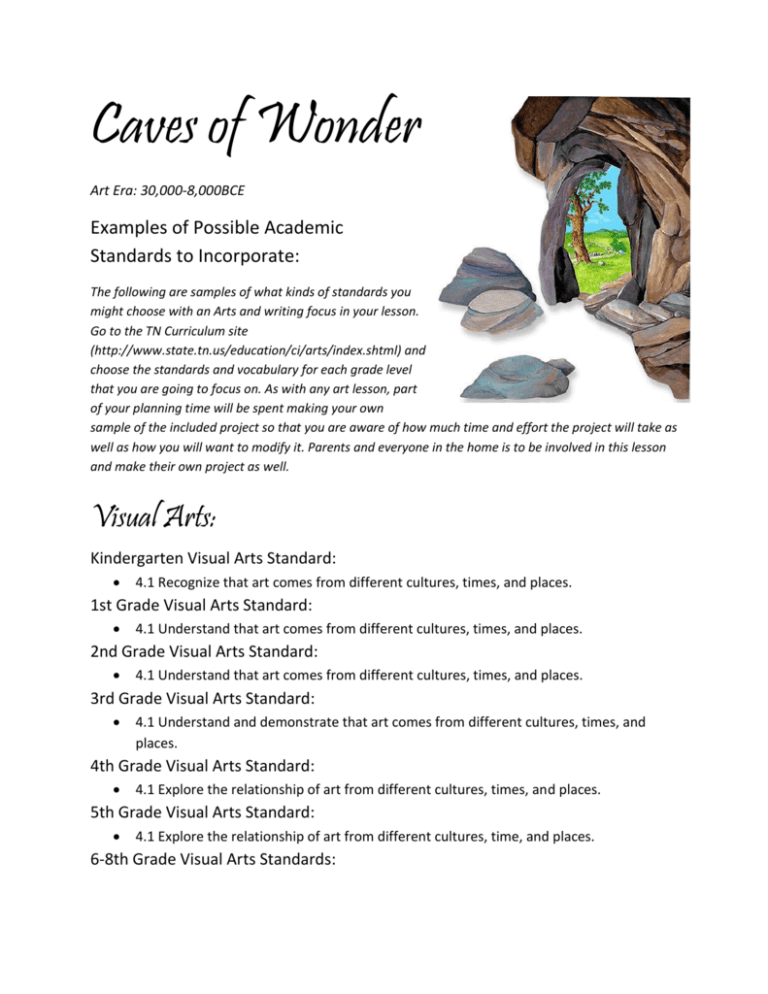
Caves of Wonder
Art Era: 30,000-8,000BCE
Examples of Possible Academic
Standards to Incorporate:
The following are samples of what kinds of standards you
might choose with an Arts and writing focus in your lesson.
Go to the TN Curriculum site
(http://www.state.tn.us/education/ci/arts/index.shtml) and
choose the standards and vocabulary for each grade level
that you are going to focus on. As with any art lesson, part
of your planning time will be spent making your own
sample of the included project so that you are aware of how much time and effort the project will take as
well as how you will want to modify it. Parents and everyone in the home is to be involved in this lesson
and make their own project as well.
Visual Arts:
Kindergarten Visual Arts Standard:
4.1 Recognize that art comes from different cultures, times, and places.
1st Grade Visual Arts Standard:
4.1 Understand that art comes from different cultures, times, and places.
2nd Grade Visual Arts Standard:
4.1 Understand that art comes from different cultures, times, and places.
3rd Grade Visual Arts Standard:
4.1 Understand and demonstrate that art comes from different cultures, times, and
places.
4th Grade Visual Arts Standard:
4.1 Explore the relationship of art from different cultures, times, and places.
5th Grade Visual Arts Standard:
4.1 Explore the relationship of art from different cultures, time, and places.
6-8th Grade Visual Arts Standards:
4.0 Historical and Cultural Relationships: Students will understand the visual arts in
relation to history and cultures
4.1 Demonstrate an understanding of the historical and cultural contexts of artwork.
4.2 Demonstrate an understanding of the role of artists throughout history and cultures.
9-12th Grade Art History Standards:
3.3 Identify the repetitive use of subject, themes, and/or symbols by a culture, time
period, or individual artist/architect. [Infer, from given works of an artist, culture or time
period, the importance, and shared meaning in the use of themes, symbols, or ideas.]
4.0 Historical and Cultural Relationships: Students will understand the visual arts in
relationship to history and cultures.
4.1.2 Speculate on how factors of time and place (e.g., climate, resources, ideas,
technology) give meaning to art and architecture.
English/Language Arts:
Kindergarten English/Lang Arts Standard:
1.3.3 Compose simple stories with teacher assistance.
1st Grade English/Lang Arts Standard:
1.3.1 Compose simple stories with a clear beginning, middle, and end.
2nd Grade English/Lang Arts Standard:
1.3.4 Revise first drafts for clearer meaning, correct capitalization, and punctuation.
3rd Grade English/Lang Arts Standard:
1.3.8 Use all steps in the writing process: brainstorm and organize ideas, create a first
draft, revise and proofread draft, share completed work.
4th Grade English/Lang Arts Standard:
1.3.8 Use all steps in the writing process: brainstorm and organize ideas, create a first
draft, revise and proofread draft, share completed work.
5th Grade English/Lang Arts Standard:
1.3.13 Compose clear, coherent, well-organized multi-paragraphed works.
6th Grade English/Lang Arts Standard:
1.3.3 Organize ideas into an essay with an introduction, developing paragraphs,
conclusion, and appropriate transitions.
7th Grade English/Lang Arts Standard:
1.3.3 Organize ideas into an essay with an introduction, developing paragraphs,
conclusion, and appropriate transitions.
8th Grade English/Lang Arts Standard:
1.3.3 Organize ideas into an essay with an introduction, developing paragraphs,
conclusion, and appropriate transitions.
9th-12th Grade English Course Standards:
1.3.3 Organize ideas into an essay with a thesis statement in the introduction, wellconstructed, paragraphs, a conclusion, and transition sentences that connect
paragraphs into a coherent whole.
1.3.4 Revise documents to develop or support ideas clearly, address potential
objections, ensure effective transitions between paragraphs, and correct errors in logic.
1.3.6 Include relevant, specific, and compelling details.
1.3.18 Practice writing to a prompt within a specified time limit.
9th-12th Grade Creative Writing Course Standards:
Content Standard:
The student will be given the opportunity to develop this creative outlet through additional
writing experiences.
Goal Statement:
Students often have the opportunity to experience expository writing in the classroom but have
little time to develop imaginative writing. Creative Writing allows them to promote selfexpression, to explore various writing styles, and to strive for variety in diction, sentence
structure, and format.
Learning Expectations:
• Develop fluency, logic, clarity, and creativity.
• Write for a variety of audiences.
• Explore diverse modes and genres of writing.
• Utilize evaluation and revision skills.
• Focus on the steps of the process writing.
• Use available technology in the creative process.
Examples of Possible Visual Arts Vocabulary to Incorporate:
The following are a few samples of what kinds of vocabulary words from the K-12 Visual Arts Vocabulary
Glossary you might choose to incorporate naturally with your lesson. To see and choose additional
vocabulary go to: http://www.state.tn.us/education/ci/arts/doc/ART_VA_Glossary.pdf.
Abstract art: Artwork in which the subject is often simplified, distorted, deconstructed,
or obscured.
Art Criticism: Describing and evaluating the media, processes, and meanings of works of
visual art and making comparative judgments. Its four stages are description, analysis,
interpretation, and judgment.
Art History: A record of the visual arts, incorporating information, interpretations, and
judgments about art objects, artists, and conceptual influences on developments in the
visual arts.
Artifact: An object from a particular culture or stage of technological development.
Carving: A subtractive form of sculpture, in which the material is cut, chipped, or drilled
away from a solid material to create a sculpture.
Content: Meaning, significance, and information in a work of art.
Context: The interrelated conditions (cultural, political, social, economic) in which
something exists or occurs.
Culture: The sum of attitudes, customs, and beliefs that distinguishes one group of
people from another. Culture is transmitted from one generation to the next through
language, material objects, ritual, institutions, and art.
Drawing: Mark making using pencil, pen, brush, charcoal, crayon, pastel, or stylus.
Function/Functional: Purpose of an art work; utilitarian or decorative.
Examples of Possible Academic Vocabulary to Incorporate:
The following are a few samples of what kinds of vocabulary words from the TN Academic Vocabulary
Manual you might choose to incorporate naturally with your lesson. The following are Social Studies
Vocabulary words, which go with a historical emphasis, to see and choose from additional vocabulary go
to: http://www.state.tn.us/education/ci/doc/VOCABULARY.pdf .
Kindergarten:
Family
Human
Leader
1st Grade:
Past
Present
Future
History
nd
2 Grade:
History
Community
Job
Country
Continent
Culture
Values
Events
Timeline
Symbol
rd
3 Grade:
Artifact
Geography
Global
Ancestor
th
4 Grade:
Ancient Civilizations
Exploration
th
5 Grade:
Bias
Historian
Oral History
th
6 Grade:
Ancient
Civilizations
Technological
th
7 Grade:
Impact
Physical Processes
Demographics
th
8 Grade:
Human impact
Relative
Vernacular
Custom
Population
Landforms
Tools
Weapons
Population
Religion
Anthropology
Archeologists
Geologist
Caves of
Wonder
Art Era: 30,000-8,000BCE
Humans make art. We do this for
many reasons and with whatever
tools are available to us. Humans
have made art as long as they have
existed. Extremely old jewelry has
been found across Africa. The oldest
firmly-dated example is a collection
of 82,000 year old snail shells found
in Morocco that are pierced and
covered with red ochre, that may
have been used as strung beads for a necklace. Snail shell beads found in Israel may be more
than 100,000 years old and in the Blombos cave in South Africa, pierced shells and small pieces
of ochre (red Haematite) etched with simple geometric patterns have been found in a 75,000year-old layer of dirt.
Archeological discoveries across a big
swipe of Europe (especially Southern
France, Northern Spain, and Swabia,
in Germany) include over two
hundred caves with spectacular
paintings, drawings and sculpture that
are among the earliest known
examples of human art. The oldest of
these is a 2.4-inch tall female figure carved out of
mammoth ivory that was found in six different pieces
in the Hohle Fels cave near Schelklingen in southern
Germany. It dates to 35,000 B.C.E, meaning it was made over 37,000 years ago. (The Venus of
Hohle Fels. Foto: H. Jensen. Copyright: Universität Tübingen. All rights reserved.)
The very first cave paintings were discovered in 1896 in the Altamira Cave in Santander, Spain.
These paintings dated back to 14,000 BC and showed bison over 8′ long!
When you think of a cave, you might think of a big place, with high ceilings. Not so. In order to
reach the places where cave paintings have been found, the people who made the art had to
crawl on their bellies, through mazes of narrow, dark tunnels, by the light of a flicking torch or a
hand carved spoon-like oil lamp (which had to be hand carried and balanced carefully to hold
the burning oil in the rounded part of the spoon - while crawling along on your belly), and
carrying the paints they had carefully prepared. As they crawled in with no idea if they might
run into, oh, a cave lion, snakes, or a bear, on the way.
Today, if you want to make art you have many
things you can use. There is paint, crayons,
markers, pencils, pens and a lot of other
supplies you can buy at the store. Since the Ice
Age, when the cave painters lived, was
thousands of years ago, they had no paint or
art supplies and couldn’t go anywhere to buy
them. They had to make them all themselves.
Instead of ink or paint, cavemen used , red
ochre and black manganese to write with or
charcoal. The inks and dyes they used came
from plants, animal blood, sap from trees and
plants, and many other things found in nature
and painted on with their fingers, sticks,
leaves, and animal hair. Certainly they weren’t just decorating their homes, as these marvelous
paintings were hidden deep within the darkest portions of the cave.
The caves at Chauvet-Pont-d'Arc, Lascaux, Pech Merle, and Altamira contain the best known
examples of pre-historic painting and drawing. The Chauvet cave, which has the oldest cave
paintings ever found,
was first explored in
1994 and apparently
no humans had been
anywhere near the
Chauvet cave for
thousands of years.
These were the
oldest cave paintings
ever discovered.
These paintings could
have been created up to 32,000 years ago, but they look as though they were just painted
yesterday. And not only do these paintings have animals on them, the Chauvet cave also has a
whole wall full of hand prints. This cave is probably one of the best examples of cave painting
ever discovered. (After its discovery, the French government decided to close Chauvet Cave to
the public, to protect it, giving a professional research team the only access.)There are amazing
images of animals and some humans that were created using a complicated mix of naturalism
(making things look real) and abstraction (not realistic). Most of the humans are made as stick
figures, while many of the animals are amazingly realistic. Some people wonder why, if these
Ice Age Europeans could make such amazingly realistic images of the beasts around them, why
didn’t they draw themselves? The small amount of drawings of humans must have been a
choice on their part, but we don’t know why they made that choice.
Some subjects, such as insects and rodents, were completely ignored by Paleolithic artists.
Birds, snakes, and fish are rare, as are owls, hyenas, and panthers (which appear in Chauvet).
Paleolithic artists also chose to ignore their surroundings: pictures of clouds, rain, the sun,
trees, rivers, or mountains have yet to be found. There are also no drawings of huts, tents, or
campfires.
Kids made one of the greatest discoveries of these hidden art galleries.
In 1940, a group of schoolboys in the south of France were
searching for a treasure of fabled gold when they stumbled across
treasure of another kind, the
entrance to a cave that had been
hidden by the roots of a tree.
Some versions of the story say
that the boys’ dog went down
the hole and they found it when
they heard him barking. Going down the tunnel they found
underground caverns decorated in a dazzling array of 17,000year-old paintings and engravings. Uncertain about what
they’d really seen, the boys brought in a teacher and then
experts to confirm the cave art’s authenticity. Eventually, the
French teens grew up to become caretakers of their
incredible find. Interestingly, during the war, the Resistance
used the cave "as a secret storehouse for munitions" The
cave was reopened for visitors in 1948 and two of the discoverers "guided the first visitors and
were appointed official guardians and guides. One remarkable fact about this cave is that
because it was sealed for over 17,000 years, the artwork was vibrantly colorful. As time went
by, the presence of so many visitors began a process of deterioration and the colors began to
fade and disappear. Subsequently, the original cave was
carefully copied and then closed to all but scholars. Once
people knew these paintings existed, people went looking for
more such caves, and found them! There are probably more caves with cave paintings yet to be
found!
(Read The Secret Cave: Discovering Lascaux by Emily Arnold McCully for a beautiful introduction
to cave paintings and this particular story. Another good book related to this topic is First
Painter by Dawn Sirett.
What was so interesting about this find, the cave at Lascaux, was that it showed many different
kinds of animals. Why do you think this is so? One idea is that they were painted at different
times. Now, why do you think there are so many different animals? That’s right! They are from
different times. Each group of animals likely represents a hunt or a story that was performed at
a different time. It would seem as though they used this cave over and over again for artwork,
with many different artists taking turns and telling stories.
Archeologists that study Paleolithic (Old Stone Age) era humans, believe that the paintings
discovered in 1994, in the cave
at Chauvet-Pont-d'Arc in the
Ardèche valley in France, are
more than 30,000 years old. The
images found at Lascaux and
Altamira are more recent, dating
to approximately 15,000 B.C.E.
The paintings at Pech Merle date
to both 25,000 and 15,000 B.C.E.
The cave at Chauvet-Pont-d'Arc
is over 1,000 feet in length with
two large chambers. When it
was tested the charcoal used to
draw the two head-to-head
Rhinoceroses (see the picture)
was found to have been used
between 30,340 and 32,410
years before 1995 when the
samples were taken. The cave's
drawings depict other large animals including horses, mammoths, musk ox, ibex, reindeer,
aurochs, megaceros deer, panther, and owl (these animals were not then a normal part of
people's diet, why do you think they drew them?)
What is even more interesting is that a very long time ago, when cave men were alive, it is
believed that only a few very special people were allowed to create art. They were called
Shaman or hunter-magicians. It is thought that early cave men believed that if they drew an
animal on a wall, they would capture its spirit and the Shaman would be able to control the
success of the hunt.
So, if they drew bison on a wall, what animal do you think the Shaman might have been trying
to control with their art? That’s right! In the Altamira Cave from Spain, they were trying to
control bison. But, in the cave paintings from the Hall of the Bulls, what animal do you think
they were trying to control? I’ll give you a hint: the name of the Cave is Hall of the Bulls. That’s
right! They were probably trying to control bulls and ensure the hunters a good hunt.
Who did it?
They even signed their work! For about as long as humans have
created works of art, they’ve also left behind handprints.
People began stenciling, painting, or chipping imprints of their
hands onto rock walls at least 30,000 years ago, An illustrative
example concerns the Cosquer Cave (Marseille, France), where
55 handprints have been found. Hand stencils were created by
blowing pigments onto a hand placed against the wall.
In the past most scientists have assumed that prehistoric
handprints on cave walls were male, but Professor of
Archaeological Anthropology Dean Snow says: “The very long
ring finger on the left is a dead giveaway for male hands. The one on the right has a long index
Girl’s Hand
Boy’s Hand
finger and a short pinky – thus very feminine.”
It’s All in Your Perspective
Why did the cavemen draw or paint on their walls? Some people believe that the people who
lived in caves just wanted to decorate their walls, as we do today. Some scientists think that
because cavemen had no written language they communicated their stories by using pictures
instead. For example, if the people had a really successful hunt, they would tell the story of that
in their paintings. Other people believe that the cave people thought that painting animals on
their walls would make animal spirits come to them and bring good fortune. Others believe that
the cave paintings sometimes sent messages to other people passing through or living in the
cave in the future. We have not determined if any of the symbols on the cave walls mean
anything, and if they do mean something, researchers aren't sure what the meanings are. We
may never know for sure.
Photographs of the cave at Chauvet-Pont-d'Arc show that the drawings were very carefully
created but what we see may be misleading. We see a group of horses, rhinos and bison and
we see them all at the same time, as a group, overlapping, some bigger than normal, some
smaller than they would really be in comparison to the other animals. But the photograph
changes the way these animal figures would have been originally seen. The bright electric lights
we use let us see everything at the same time; it would have looked very different to the
people who lived then, seeing each animal under the flickering light cast by a flame.
What can we really know about the creators of these paintings and what the images and arts
originally meant? These are questions that are difficult enough when we study art made only
500 years ago. How much more risky, to decide what the art means of people who were
human, like us, but who lived in a different time, a different world, and led completely different
lives from us. Do the tools of art history even apply? We can find common ground in the
pictures, a visual language that collapses the more than 1,000 generations that separate us, but
we must be careful when we decide we know what they meant by it. Especially so if we want
understand the people that made this art as a way to understand ourselves. The desire to guess
and form ideas based on what we see and the physical evidence of their artwork is very
tempting, but we must realize that we could be very wrong. Perhaps these are far more
sophisticated artworks than we have imagined, or perhaps they are far more simple, and fun.
Missing Fingers in Art: Ritual, Disease, Frostbite, or
Kids Playing?
In his book, The Nature of Paleolithic Art, Dale Guthrie overturns many of the standard
interpretations of the ancient cave paintings. Among other things, Guthrie argues that many of
the cave paintings were not just done by old men or women, but were done by children and
have similarities with present-day graffiti on building walls.
Many hand images in the French
Gargas-Tibran cave complex and
Cosquer and in Maltravieso Cave in
Spain appear to have missing
fingers or other malformations.
These "disfigured" handprints have
fueled discussions for the last 100
years since they were found.
The central issue, of course, is that
virtually all apparent mutilations,
amputations, or diseased hands
are also replicable by simply twisting the fingers in the stenciled hand (as one does in shadow
art) to make different shapes. But many people still insist that these represent real ritual
amputations where the people cut off their own, or each others fingers, or are the results of a
disease where the fingers fell off, or were because of frostbite.
These strange handprints will, no doubt, continue to puzzle and prompt discussion on what
might really be the answer, but Dale Guthrie says, “Having played with making spatter stencils
of my own hands, I find the ease with which one can replicate the "maimed-hand look" has left
me very convinced that all, or virtually all, were done in fun, especially when we recall that
these are largely young people's hands and appreciate the quick, almost careless, casualness
with which they were made. This phenomenon of altering the hand stencil patterns by finger
contortion is also well documented from a number of other cultures.”
So you decide, do you think those strange looking handprints were made by maimed broken
hands due to disease or amputation, or a bunch of ancient teenagers having fun?
Cave Painting Art
Inspired by and adapted from the Buffalo Art Lesson by
Patty at Deep Space Sparkle.
http://www.deepspacesparkle.com/2010/06/buffalopainting-art-project/
Cave Animals…
12″ x 18″ black drawing paper
White oil pastel
Small sponge
Brown tempera paint (if you don’t have,
or don’t want to use paint, this project
can be done with chalk pastels and oil
pastels)
scissors and glue
For the Background…
12″ x 18″ white drawing paper (or brown)
Earth colored tempera paints (or pastels)
Brushes
Step One: Drawing the
Animals, ex: Bison
Demonstrate a simple drawing of an animal,
ex. bison. Remember to point out the very
big head and
rather small legs!
See the picture for
a good example.
Using a pencil and
scratch paper,
your child can
make a few preliminary sketches of the animals he would like to
include in his painting. He may want to follow in the steps of the cave artists, or he may prefer
to depict animals he is familiar with, such as cats arching their backs, dogs barking or birds
flying in flocks. Whichever subjects he chooses, remind him that he need not include every
detail but can make his creatures from simple shapes, such as circles, triangles and rectangles.
He should not worry if his animals don't look exactly like those in photographs--after all, neither
do the original cave paintings.
Using a white oil pastel, have students begin at one end of the black paper and draw the eye.
Then, draw one tusk, the big forehead and then the back. Make sure the shoulder goes up and
up (think hunchback) and curve downwards for a small butt. Add legs and other details.
Using a small sponge and some brown tempera paint (or pastels), dab the paint around the
shoulder and head area to fill in the hair.
Step Two: Cutting out the Animals, ex. Bison
After the paint dries, or once you’ve filled in
with pastels, cut along the white line of the
bison. Some kids made smaller bison and
had extra room on their black paper for
another animal. Option: They can draw and
paint as many as they would like in different
sizes and layer them, as was done in the
caves.
Step Three: Painting the
Background
Using a palette of earth colors (encourage
mixing here), have students create their
cave walls. Option, they can make a line across the length of the page as a horizon. The sky will
be above this line and the earth will be below, then students can make their own landscape.
Some may use browns, oranges and yellows (cave wall colors) while others may use traditional
blues and greens. Whatever choice they make is fine. After the paint dries, glue on the bison.
Have students “sign” their work by cutting out a small
handprint on cardstock, see
sample sheet, and using a
sponge dab paint around it, or
rub chalk around the outer
edges, just like an ancient artist
would.
Variations:
If you don’t have time for students to paint or color a whole sheet for their background,
use brown drawing/construction paper and have students use pastels in earth tones to
shade it so it looks like a cave wall.
Or, help your students prepare the surface of a paper bag or a
sheet of brown paper so that it has a rough and worn
appearance, like that of a cave wall. He should crinkle the paper,
spray it with water in the sink (don't soak), then let it dry
completely (you can help him use a hair dryer to speed the drying
time). To frame the finished drawing, mount it on a piece of black
construction paper using glue or rubber cement.
If your students really take to this
project, they may want to try
creating an even more authentic
cave painting, using another sheet
or a large flat stone for his canvas and, with your help,
natural materials (soil, leaves, dandelions, a charred stick)
for drawing.
Two Perspectives
Once they’ve completed their cave art have
students use the following journal pages
to write and tell the story of their
Paleolithic discovery. Then have them
use the parchment to write their
own story of their drawings, as
though they were an ancient cave
painter.
For the Modern Perspective [Discovery
Journal] discuss the following: The world will want to
read your tale of your adventures in discovering these ancient
artworks, just like the world wanted to know the story of the French boy’s
discovery of the cave at Lascaux. How did you find the cave? Was it on purpose,
or by accident? What was it like inside? Was it underwater or on dry land? What led to your
discovery of the artworks? What do you think they mean? How old
might they be? Etc. Have them think of the story, The Secret Cave,
what kinds of details were given in that story?
For the Paleolithic Perspective discuss the following: Have
students think of the reasons the child painted in the story First
Painter by Dawn Sirett, then think about their own drawings and
create a story, as though they were an ancient cave painter. Get
them thinking by asking questions like the following: What led them
to the cave? Why did they draw what they did? Who are they? A
child, an adult, a very old person? What is happening in their life that
made them
draw those
pictures? Was
the cave easy to
get to?
Hidden Meanings
Have students try and interpret the meaning of the following
images of cave art as if they are archeologists or cave explorers
who discovered the hidden cave. Have students write and
present their ideas to the group and allow the group to vote on
what they think is the best interpretation of the meaning of the
artwork and what might have prompted the creativity of the artists. As they work, have
students think of the reasons the child painted in the story First Painter by Dawn Sirett, what
other reasons can they think of?




